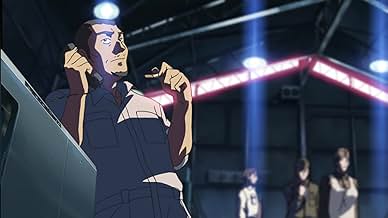ÉVALUATION IMDb
6,8/10
15 k
MA NOTE
Ajouter une intrigue dans votre langueIn an alternate postwar timeline, Japan is divided into the Union-controlled North and the US-controlled South.In an alternate postwar timeline, Japan is divided into the Union-controlled North and the US-controlled South.In an alternate postwar timeline, Japan is divided into the Union-controlled North and the US-controlled South.
- Prix
- 1 victoire et 1 nomination au total
Yuka Nanri
- Sayuri Sawatari
- (voice)
- (as Yuuka Nanri)
Unshô Ishizuka
- Okabe
- (voice)
Kazuhiko Inoue
- Tomizawa
- (voice)
Risa Mizuno
- Maki Kasahara
- (voice)
Hidenobu Kiuchi
- Arisaka
- (voice)
Takeshi Maeda
- Daigakuinsei
- (voice)
- …
Rie Nakagawa
- Joshi Seito
- (voice)
- …
Yûki Nakao
- Joshi Seito
- (voice)
Maki Saito
- Joshi Seito
- (voice)
- (as Maki Saitou)
- …
Kousuke Kujirai
- Danshi Seito
- (voice)
Bretto Coleman
- Beigunjin
- (voice)
Ian O'Neal
- NSA
- (voice)
Histoire
Le saviez-vous
- AnecdotesMakoto Shinkai intended to draw the background art himself but with an estimated 1000 cuts needed this would have been impossible for Shinkai to do alone and the film's animation producer, Kiyonori Hiramatsu went to Tokyo Art University to scout for artists. Adding to complications, many of the students were recruited from oil painting classes and had no experience in creating digital backgrounds and many hadn't even used PCs before.
- GaffesEnglish subtitles spell prophecies (used as a noun) as prophesies (the verb).
- Citations
Hiroki Fujisawa: [Narrating] Living alone, the nights seemed to last forever. When I couldn't pass the time effectively, I went to a nearby train station and pretended to wait for someone.
- Générique farfeluThere's a brief shot after the credits.
- ConnexionsFeatured in WatchMojo: Top 10 Underappreciated Anime Movies (2016)
Commentaire en vedette
This is an anime movie done by a relative newcomer to films: Makoto Shinkai, whose only previous directorial work was a half-hour short called "Voices of a Distant Star," in which he did all the animation himself on one laptop (even for Japan, a nation of workaholics, that was unheard of). It made him so famous that they gave him a full studio to work with for his next project, and when Makoto Shinkai doesn't have the constraints that a solo project would bring, look out.
The style of the film and its sci-fi and fantasy themes is equal parts steampunk and cyberpunk, with the film taking place in an alternate timeline of post-war Japan, only a few years from now. The main differences are the division between the North and South sides of Japan, and the research into parallel universes that has sprung up, resulting in the construction of a massive tower in Ezo (Hokkaido), which understandably captures the imagination and curiosity of the surrounding world.
Though the film is ostensibly a science fiction work, the plot involving a tower and alternate realities and so on plays second fiddle to the romantic drama, about three high school kids torn apart by war. The emotions blend with the fantasy elemts in a way that is handled with incredible elegance, care and sensitivity, and Makoto Shinkai's trademark poetic touch.
But what is more impressive is how the film shows that drama can be achieved through implausible situations. You see, too many directors think that in order to make a film "dramatic" and "touching," it must be about REALISTIC people in a REALISTIC setting having REALISTIC problems with REALISTIC resolutions, but Makoto Shinkai realizes a way around that, and uses a science fiction element not as a platform for action sequences, but rather as a way to achieve a kind of drama that you really couldn't get in a film that takes place in the "real world."
The film is aware that the sci-fi is playing second fiddle to the character drama, and doesn't waste any more time than it needs to trying to explain the film's bizarre sciences or justify the contrivances, rather leaving it up to the viewer to interpret and decipher what the fantasies of the film mean or symbolize. In other words, Shinkai wisely avoids the deathtrap of "Movie Science," and instead allows the audience to take things as they come and explain them ourselves.
The part about two teenagers building a plane that could get past a government-built radar system does seem a bit incredible, but this film does reflect on the incompetence of governments and how easy it is to get past them, so the required suspension of disbelief isn't really that big (I wish I found it hard to believe that a couple of teenagers could get past a bureaucratic governmental system in this day and age at all).
Also, the brief violence and "thrilling" assault on the tower are treated with perfect sincerity. The brief fight scenes are breathtaking in their realism and how they show that when someone gets punched, they get hurt. There are no legendary martial arts techniques or complex laser-rifle technology here, this film is about how people feel about each other and what they do when they are in trouble.
The ending is slightly abrupt and somewhat open-ended (although it is happy), but that is a theme in many anime. A lot is left up to the audience's interpretation and imagination, and the film only answers the questions that really matter.
The style of the film and its sci-fi and fantasy themes is equal parts steampunk and cyberpunk, with the film taking place in an alternate timeline of post-war Japan, only a few years from now. The main differences are the division between the North and South sides of Japan, and the research into parallel universes that has sprung up, resulting in the construction of a massive tower in Ezo (Hokkaido), which understandably captures the imagination and curiosity of the surrounding world.
Though the film is ostensibly a science fiction work, the plot involving a tower and alternate realities and so on plays second fiddle to the romantic drama, about three high school kids torn apart by war. The emotions blend with the fantasy elemts in a way that is handled with incredible elegance, care and sensitivity, and Makoto Shinkai's trademark poetic touch.
But what is more impressive is how the film shows that drama can be achieved through implausible situations. You see, too many directors think that in order to make a film "dramatic" and "touching," it must be about REALISTIC people in a REALISTIC setting having REALISTIC problems with REALISTIC resolutions, but Makoto Shinkai realizes a way around that, and uses a science fiction element not as a platform for action sequences, but rather as a way to achieve a kind of drama that you really couldn't get in a film that takes place in the "real world."
The film is aware that the sci-fi is playing second fiddle to the character drama, and doesn't waste any more time than it needs to trying to explain the film's bizarre sciences or justify the contrivances, rather leaving it up to the viewer to interpret and decipher what the fantasies of the film mean or symbolize. In other words, Shinkai wisely avoids the deathtrap of "Movie Science," and instead allows the audience to take things as they come and explain them ourselves.
The part about two teenagers building a plane that could get past a government-built radar system does seem a bit incredible, but this film does reflect on the incompetence of governments and how easy it is to get past them, so the required suspension of disbelief isn't really that big (I wish I found it hard to believe that a couple of teenagers could get past a bureaucratic governmental system in this day and age at all).
Also, the brief violence and "thrilling" assault on the tower are treated with perfect sincerity. The brief fight scenes are breathtaking in their realism and how they show that when someone gets punched, they get hurt. There are no legendary martial arts techniques or complex laser-rifle technology here, this film is about how people feel about each other and what they do when they are in trouble.
The ending is slightly abrupt and somewhat open-ended (although it is happy), but that is a theme in many anime. A lot is left up to the audience's interpretation and imagination, and the film only answers the questions that really matter.
- StarAxis
- 7 juin 2005
- Lien permanent
Meilleurs choix
Connectez-vous pour évaluer et surveiller les recommandations personnalisées
- How long is The Place Promised in Our Early Days?Propulsé par Alexa
Détails
- Date de sortie
- Pays d’origine
- Site officiel
- Langue
- Aussi connu sous le nom de
- The Place Promised in Our Early Days
- société de production
- Consultez plus de crédits d'entreprise sur IMDbPro
Box-office
- Brut – à l'échelle mondiale
- 44 483 $ US
- Durée1 heure 30 minutes
- Couleur
- Mixage
- Rapport de forme
- 1.85 : 1
Contribuer à cette page
Suggérer une modification ou ajouter du contenu manquant

Lacune principale
What is the French language plot outline for Kumo no mukô, yakusoku no basho (2004)?
Répondre





















